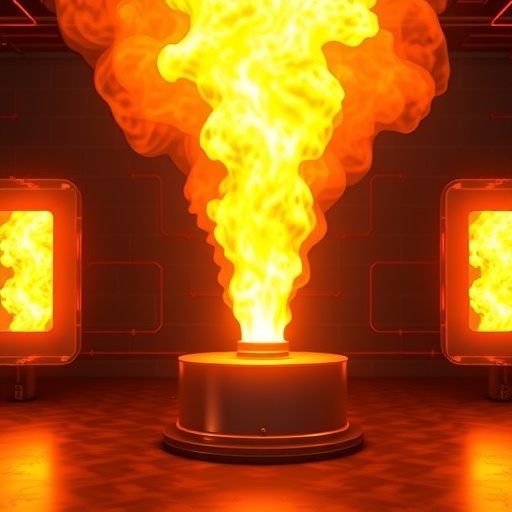In a groundbreaking advancement for the field of nuclear fusion, researchers led by Brian Spears have successfully developed a generative machine learning model capable of accurately predicting the outcome of inertial confinement fusion experiments at the U.S. National Ignition Facility (NIF). This breakthrough model forecasts fusion ignition events with a probability exceeding 70%, marking a substantial leap forward in our ability to foresee and optimize fusion energy outcomes. The implications of this technological advancement extend beyond mere prediction; it offers a powerful tool to accelerate experimental design, guide laser parameter adjustments, and push the boundaries of fusion research.
Fusion ignition represents a pivotal milestone in the quest for sustainable fusion energy, defining the moment when the energy generated by fusion reactions surpasses the input laser energy used to initiate the process. At NIF, scientists use powerful lasers to compress and heat capsules filled with hydrogen isotopes, triggering nuclear fusion reactions. Achieving ignition has remained a formidable challenge for decades until a historic experiment in 2022 succeeded in crossing this threshold, proving the possibility of net energy gain from fusion reactions. Spears and his team’s model was able to anticipate this rare feat, underscoring the model’s potential as a predictive compass for the future of fusion research.
The model developed by Spears et al. is not merely a black-box algorithm; rather, it synthesizes rich experimental datasets, advanced radiation hydrodynamics simulations, and the rigorous frameworks of Bayesian statistics to produce physically informed predictions. This fusion of physics-based understanding with state-of-the-art machine learning techniques enables the model to not only predict outcomes but also provide probabilistic confidence levels. Such an integrative approach ensures that the model respects the underlying physical phenomena while leveraging the pattern-recognition prowess of deep learning architectures.
A critical component of the model’s success lies in its ability to assimilate comprehensive experimental data from the NIF facility. These datasets encompass detailed diagnostics of laser performance, capsule implosion dynamics, and fusion yield measurements—each parameter capturing different facets of the complex fusion process. Additionally, the model capitalizes on radiation hydrodynamics simulations, which simulate the behavior of the fuel capsule under extreme conditions, incorporating laser energy deposition, plasma dynamics, and radiation transport. By integrating this multi-sourced information, the model develops a nuanced understanding of how varying experimental conditions influence ignition probability.
Another noteworthy innovation in this work is the application of Bayesian statistical methods within the machine learning framework. Bayesian statistics enable the model to quantify uncertainty and incorporate prior scientific knowledge, fostering a more robust and interpretable prediction mechanism. This statistical backbone strengthens the model’s capacity to make reliable predictions even when experimental data are sparse or noisy, a common challenge in cutting-edge fusion experiments. Consequently, researchers can place greater confidence in the model’s guidance for iteratively refining experimental parameters.
The utility of the model extends far beyond prediction accuracy; it serves as a strategic advisor for experimental design at NIF and similar facilities. By quickly evaluating how modifications in laser energy, pulse shape, capsule composition, and other variables impact the likelihood of ignition, the model helps streamline experimental planning. This capability minimizes costly trial-and-error approaches, accelerating the path toward higher fusion yields and more efficient energy production. Such an accelerated research cycle is vital for realizing fusion energy as a viable, clean power source in the foreseeable future.
Importantly, the success of this predictive machine learning tool demonstrates the growing synergy between physics-based simulations and artificial intelligence. Traditional simulation methods alone, while invaluable, are computationally intensive and time-consuming. The incorporation of deep learning algorithms dramatically reduces the time required to explore parameter spaces, enabling rapid hypothesis testing and optimization. Furthermore, as more experimental data are accumulated, the model’s predictive power is expected to improve, evolving into an even more indispensable component of fusion research.
Beyond the immediate realm of inertial confinement fusion, the methodological advancements showcased in Spears et al.’s work hold promise for other complex, high-energy physics applications. By coupling physics-informed machine learning with Bayesian inference, researchers can tackle similarly challenging prediction problems in plasma physics, astrophysics, and materials science. The principles underlying this approach emphasize the importance of data-driven models that remain faithful to fundamental physical laws, a paradigm that is reshaping scientific discovery across disciplines.
The success story of this machine learning model also underscores the collaborative nature of modern scientific progress. The project brought together experts in experimental fusion, computational physics, statistics, and artificial intelligence, illustrating the interdisciplinary teamwork essential to overcoming today’s scientific challenges. It highlights how cutting-edge computation and statistical methodologies can complement and enhance classical physics experiments, providing new insights that were previously unattainable.
Looking forward, the predictive model developed by Spears and colleagues is poised to play a central role as NIF and other fusion facilities pursue higher energy outputs and sustained fusion reactions. With laser technology continually advancing and experimental setups becoming increasingly sophisticated, having an agile and reliable predictive framework will be indispensable. Through iterative learning and incorporation of fresh data, the model will not only guide immediate next steps but also help chart a strategic research roadmap toward practical fusion energy.
In summary, the development of a physics-informed deep learning model capable of predicting fusion ignition with substantial confidence marks a transformative milestone in fusion science. It bridges the gap between computational prediction and experimental verification, providing a much-needed compass in the complex landscape of fusion experimentation. As fusion research accelerates, tools like these will be critical in bringing the promise of clean, abundant fusion energy closer to reality, potentially revolutionizing global energy systems for generations to come.
Subject of Research: Predictive modeling of fusion ignition using physics-informed deep learning at the National Ignition Facility.
Article Title: Predicting fusion ignition at the National Ignition Facility with physics-informed deep learning
News Publication Date: 14-Aug-2025
Web References: http://dx.doi.org/10.1126/science.adm8201
Keywords
Fusion ignition, inertial confinement fusion, National Ignition Facility, machine learning, generative model, deep learning, radiation hydrodynamics, Bayesian statistics, predictive modeling, laser parameters, nuclear fusion energy, physics-informed AI




